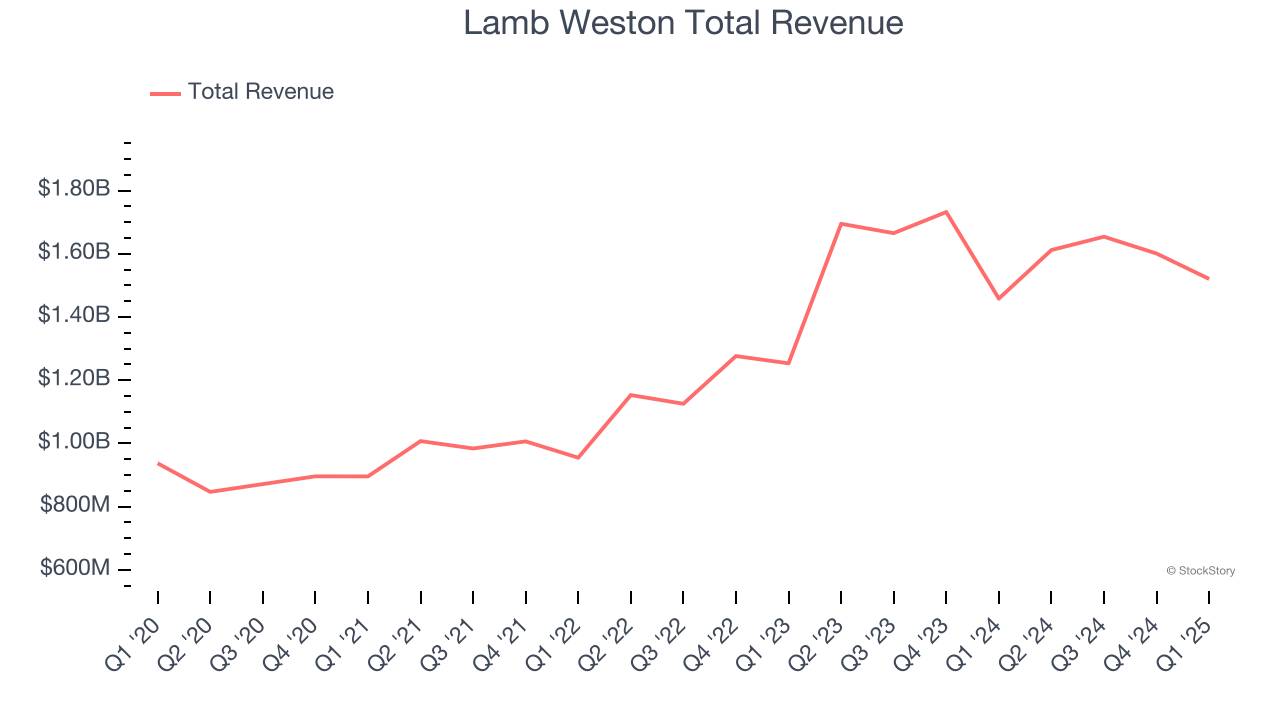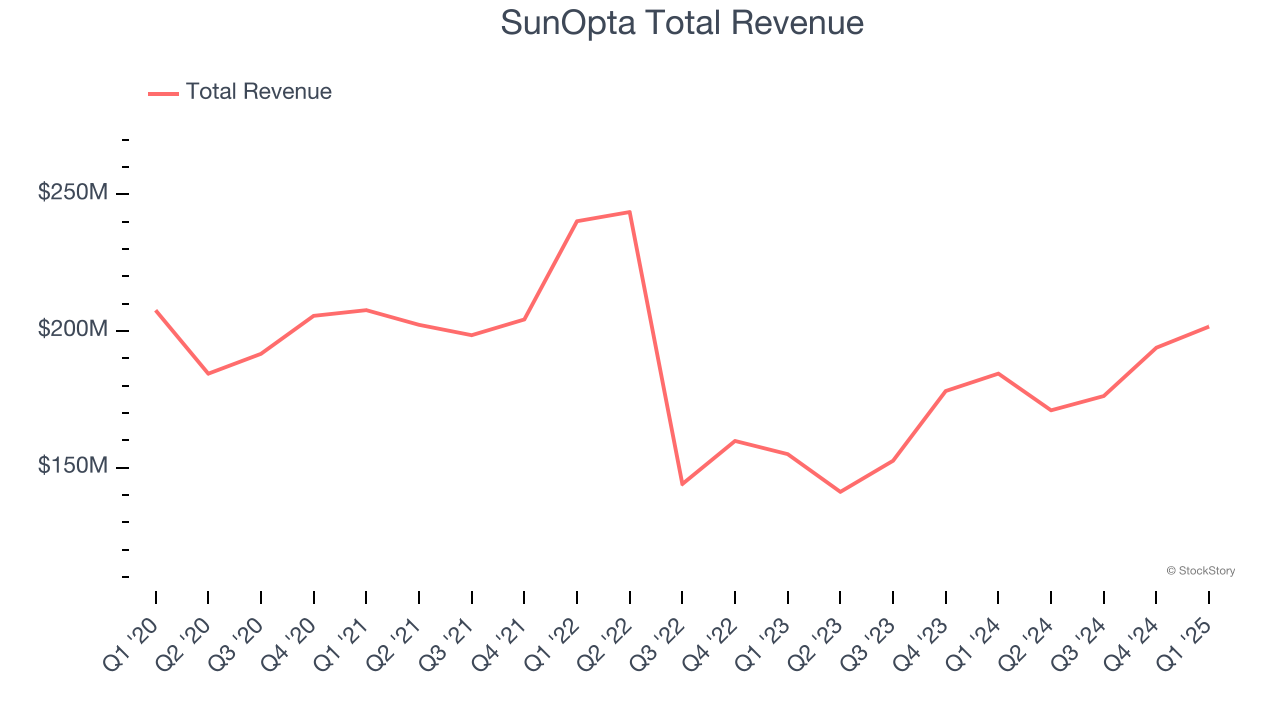
Looking back on shelf-stable food stocks’ Q1 earnings, we examine this quarter’s best and worst performers, including Lamb Weston (NYSE:LW) and its peers.
As America industrialized and moved away from an agricultural economy, people faced more demands on their time. Packaged foods emerged as a solution offering convenience to the evolving American family, whether it be canned goods or snacks. Today, Americans seek brands that are high in quality, reliable, and reasonably priced. Furthermore, there's a growing emphasis on health-conscious and sustainable food options. Packaged food stocks are considered resilient investments. People always need to eat, so these companies can enjoy consistent demand as long as they stay on top of changing consumer preferences. The industry spans from multinational corporations to smaller specialized firms and is subject to food safety and labeling regulations.
The 21 shelf-stable food stocks we track reported a mixed Q1. As a group, revenues missed analysts’ consensus estimates by 0.8% while next quarter’s revenue guidance was 0.5% above.
Amidst this news, share prices of the companies have had a rough stretch. On average, they are down 8.8% since the latest earnings results.
Best Q1: Lamb Weston (NYSE:LW)
Best known for its Grown in Idaho brand, Lamb Weston (NYSE:LW) produces and distributes potato products such as frozen french fries and mashed potatoes.
Lamb Weston reported revenues of $1.52 billion, up 4.3% year on year. This print exceeded analysts’ expectations by 2.4%. Overall, it was a very strong quarter for the company with an impressive beat of analysts’ EBITDA estimates and a solid beat of analysts’ gross margin estimates.
“As a result of the actions we took in early fiscal 2025 to drive operational and cost efficiencies, we closed the quarter with sequentially improved volume trends and profitability metrics that were in line with our previously updated fiscal 2025 outlook,” said Mike Smith, Lamb Weston’s president and CEO.

Lamb Weston pulled off the highest full-year guidance raise of the whole group. Investor expectations, however, were likely higher than Wall Street’s published projections, leaving some wishing for even better results (analysts’ consensus estimates are those published by big banks and advisory firms, not the investors who make buy and sell decisions). The stock is down 4% since reporting and currently trades at $52.
Is now the time to buy Lamb Weston? Access our full analysis of the earnings results here, it’s free.
SunOpta (NASDAQ:STKL)
Committed to clean-label foods, SunOpta (NASDAQ:STKL) is a sustainability-focused food and beverage company specializing in the sourcing, processing, and packaging of organic products.
SunOpta reported revenues of $201.6 million, up 9.3% year on year, outperforming analysts’ expectations by 3.7%. The business had a very strong quarter with an impressive beat of analysts’ EPS estimates and a solid beat of analysts’ adjusted operating income estimates.

SunOpta scored the biggest analyst estimates beat among its peers. The market seems happy with the results as the stock is up 27.8% since reporting. It currently trades at $5.80.
Is now the time to buy SunOpta? Access our full analysis of the earnings results here, it’s free.
Weakest Q1: B&G Foods (NYSE:BGS)
Started as a small grocery store in New York City, B&G Foods (NYSE:BGS) is an American packaged foods company with a diverse portfolio of more than 50 brands.
B&G Foods reported revenues of $425.4 million, down 10.5% year on year, falling short of analysts’ expectations by 6.8%. It was a disappointing quarter as it posted a significant miss of analysts’ adjusted operating income estimates.
B&G Foods delivered the weakest performance against analyst estimates in the group. As expected, the stock is down 32.5% since the results and currently trades at $4.26.
Read our full analysis of B&G Foods’s results here.
BellRing Brands (NYSE:BRBR)
Spun out of Post Holdings in 2019, Bellring Brands (NYSE:BRBR) offers protein shakes, nutrition bars, and other products under the PowerBar, Premier Protein, and Dymatize brands.
BellRing Brands reported revenues of $588 million, up 18.9% year on year. This number surpassed analysts’ expectations by 1.6%. Aside from that, it was a mixed quarter as it also produced a solid beat of analysts’ organic revenue estimates but a significant miss of analysts’ gross margin estimates.
BellRing Brands achieved the fastest revenue growth but had the weakest full-year guidance update among its peers. The stock is down 26.9% since reporting and currently trades at $57.41.
Read our full, actionable report on BellRing Brands here, it’s free.
TreeHouse Foods (NYSE:THS)
Whether it be packaged crackers, broths, or beverages, Treehouse Foods (NYSE:THS) produces a wide range of private-label foods for grocery and food service customers.
TreeHouse Foods reported revenues of $792 million, down 3.6% year on year. This print was in line with analysts’ expectations. Overall, it was a strong quarter as it also put up a solid beat of analysts’ EPS estimates and an impressive beat of analysts’ EBITDA estimates.
The stock is down 14.8% since reporting and currently trades at $19.94.
Read our full, actionable report on TreeHouse Foods here, it’s free.
Market Update
The Fed’s interest rate hikes throughout 2022 and 2023 have successfully cooled post-pandemic inflation, bringing it closer to the 2% target. Inflationary pressures have eased without tipping the economy into a recession, suggesting a soft landing. This stability, paired with recent rate cuts (0.5% in September 2024 and 0.25% in November 2024), fueled a strong year for the stock market in 2024. The markets surged further after Donald Trump’s presidential victory in November, with major indices reaching record highs in the days following the election. Still, questions remain about the direction of economic policy, as potential tariffs and corporate tax changes add uncertainty for 2025.
Want to invest in winners with rock-solid fundamentals? Check out our 9 Best Market-Beating Stocks and add them to your watchlist. These companies are poised for growth regardless of the political or macroeconomic climate.
